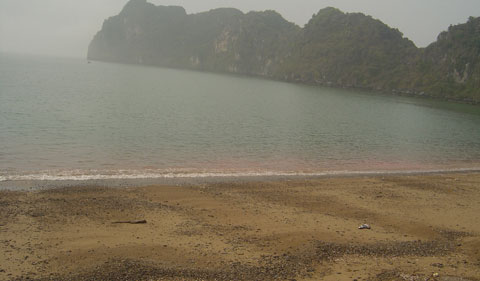Red tide in Hai Phong
Algae blooming with high density makes Cat Ba and Hai Phong waters appear "red tide", with red or pink scum layers on the water lasting more than a month.
>>>Green energy from the tide
Scientists from the Seafood Research Institute found that red tide phenomenon occurred in the coastal area of Do Son - Cat Ba. After sampling and analyzing, Dr. Nguyen Van Nguyen, Deputy Director of the Institute of Seafood Research, said that the algae adjoining Noctiluca scintillans , the red strain is the cause of red tide in the coastal area of Cat Ba.
Red tide is the common name for phenomena known as "blooming" seaweed outbreaks, which often occur in estuaries.

Red tide phenomenon, also known as "blooming" algae in the sea
Cat Ba, Hai Phong. (Photo provided by Dr. Nguyen Van Nguyen)
"From the end of March to the present, this algae has exploded with high density, creating floating water scum on the surface. The scum layer with color from light pink to red depends on the density and stage of development of algae" , Dr. Nguyen said.
According to Mr. Nguyen, due to tidal and flow interaction, some water bodies carry red tides drifting and staying in coastal areas, quiet bays, where they can continue to increase in density, creating thick layers of scum, causing dense red tidal bands in some puddles, docks, and boats along Cat Ba and Do Son islands.
Mr. Nguyen said that noctiluca scintillans does not produce toxins, so there is no risk of poisoning for humans or aquatic products. But they have the ability to accumulate ammonia in high concentrations and release it into the water environment. Their high density also causes the depletion of oxygen in the water body, which can cause death of aquatic products.
The Seafood Research Institute recommends that people should monitor and prevent negative impacts on aquaculture, especially in fish cage areas, concentrated in closed caves and bay. In the case of dense red tide bands covering fish cage farming households, the cage must be lowered to create space for fish to avoid red tidal water layer, about 3-5cm above the surface.
Red tide was first recorded in Hai Phong in June 2002. In the past year, the Seafood Research Institute discovered 3 red tide outbreaks in Cat Ba area.

Algae blooms can make the sea red, blue, or gray or rice bran.
Red tide when flooding on the coast of Binh Thuan. (Photo: Nha Trang Oceanography Institute)
In Vietnam, red tide phenomenon mainly occurs in the South Central Coast region than the Gulf of Tonkin and the South. In which Binh Thuan is a place with this phenomenon regularly, every year from March to September, especially during the southwest monsoon period.
According to Dr. Nguyen Ngoc Lam, Nha Trang Institute of Oceanography, who has many years of experience researching red tide, pre-existing seaweed in the sea, along with environmental factors, warm water, strong light can cause the phenomenon of algal blooms, creating a discoloration of water, called red tide, also known as "blooming" algae .
Dr. Lam warns, most algae blooms can make the environment worsen by reducing the amount of dissolved oxygen in the water, while also causing marine animals to die massively.
- Storm level 10 is directed at Quang Ninh - Hai Phong
- Storm No. 2 landed in the North East: break dike in Hai Phong
- Climate change changes the face of Cat Ba biosphere area
- What is the black tide? Causes and ways to overcome the black tide
- Red tide and harmful effects on seafood production
- China issued a red tide warning
- Why does such a distant Moon affect the tide on Earth?
- 'King's tide' raged on the earth
- Many Saigon roads are flooded with heavy tide
- When the tide is high, the people of Saigon reel in the sea of water
- Hundreds of households were submerged because of broken banks
- 10,000 billion VND flood-proofing project of Ho Chi Minh City
 Is the magnetic North Pole shift dangerous to humanity?
Is the magnetic North Pole shift dangerous to humanity? Washington legalizes the recycling of human bodies into fertilizer
Washington legalizes the recycling of human bodies into fertilizer Lightning stone - the mysterious guest
Lightning stone - the mysterious guest Stunned by the mysterious sunset, strange appearance
Stunned by the mysterious sunset, strange appearance